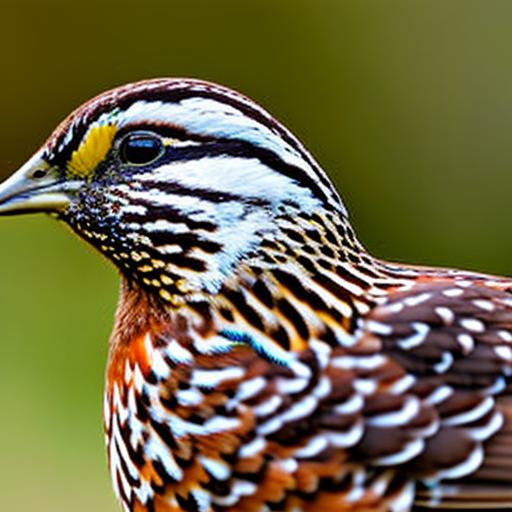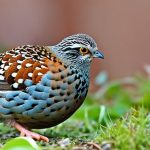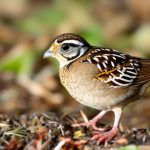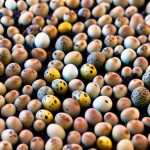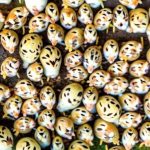The Northern Bobwhite Quail, also known as the Virginia quail, is a small ground-dwelling bird native to North America. It is a popular game bird and is highly valued for its delicious meat. The Northern Bobwhite Quail is known for its distinctive call, which sounds like “bob-white” and can be heard throughout its range. These birds are primarily found in grasslands, open woodlands, and agricultural fields, where they forage for seeds, insects, and other small invertebrates. They are social birds and often form coveys, which are groups of birds that roost, feed, and move together. The Northern Bobwhite Quail is an important species for conservation efforts due to its declining populations in recent years.
The Northern Bobwhite Quail is a small, stocky bird with a round body and short tail. It has a mottled brown and white plumage, with a distinctive black and white striped head pattern. The male Northern Bobwhite Quail has a bold black and white throat patch, while the female has a more subdued coloration. These birds are well-adapted for life on the ground, with strong legs for running and a camouflaged plumage that helps them blend into their surroundings. They are also known for their quick, explosive flight when flushed from cover. Understanding the behavior, habitat preferences, and ecological needs of the Northern Bobwhite Quail is essential for effective conservation and management efforts.
Key Takeaways
- Northern Bobwhite Quail are ground-dwelling birds native to North America, known for their distinctive call and habitat in grasslands and open woodlands.
- Creating suitable habitat for Northern Bobwhite Quail involves maintaining a mix of grasses, forbs, and shrubs, and implementing prescribed burning and rotational grazing.
- Providing adequate food and water sources for Northern Bobwhite Quail includes planting food plots, maintaining water sources, and minimizing pesticide use.
- Managing predators and threats to Northern Bobwhite Quail involves controlling invasive species, reducing feral cat populations, and minimizing habitat fragmentation.
- Implementing conservation practices for Northern Bobwhite Quail includes participating in government conservation programs, establishing conservation easements, and promoting sustainable land management practices.
Creating Suitable Habitat for Northern Bobwhite Quail
Creating suitable habitat for Northern Bobwhite Quail is crucial for their survival and population recovery. These birds require a diverse landscape with a mix of grasslands, shrublands, and open woodlands. They prefer areas with dense ground cover for nesting and brood rearing, as well as access to open areas for foraging. Creating and maintaining suitable habitat for Northern Bobwhite Quail involves a combination of habitat restoration, land management practices, and conservation efforts. This can include planting native grasses and forbs, managing woody encroachment, and implementing prescribed burning to maintain open grasslands.
In addition to habitat structure, the quality of habitat is also important for Northern Bobwhite Quail. This includes providing suitable nesting sites, brood-rearing areas, and escape cover from predators. Landowners and managers can create suitable habitat by implementing practices such as edge feathering, brush pile construction, and maintaining early successional habitats. By creating diverse and high-quality habitat for Northern Bobwhite Quail, we can help support their populations and ensure their long-term survival.
Providing Adequate Food and Water Sources
Providing adequate food and water sources is essential for supporting healthy populations of Northern Bobwhite Quail. These birds primarily feed on seeds, grains, and insects, so having a diverse mix of food sources is important for their survival. Land managers can provide food sources for Northern Bobwhite Quail by planting native grasses, forbs, and legumes that produce seeds and provide cover for insects. Additionally, maintaining open areas with bare ground can provide access to grit and small invertebrates that are important parts of their diet.
Water sources are also important for Northern Bobwhite Quail, especially during the hot summer months. Providing access to clean water through the installation of small ponds, water troughs, or strategically placed water sources can help support quail populations during dry periods. By providing adequate food and water sources, land managers can help ensure that Northern Bobwhite Quail have the resources they need to thrive in their habitat.
Managing Predators and Threats to Northern Bobwhite Quail
Managing predators and threats to Northern Bobwhite Quail is an important aspect of conservation efforts for this species. Predation is a natural part of the ecosystem, but excessive predation can have negative impacts on quail populations. Land managers can implement predator management strategies such as trapping, hunting, or using predator deterrents to help reduce predation pressure on quail populations. Additionally, managing habitat to provide escape cover and nesting sites can help reduce the vulnerability of quail to predators.
In addition to predation, other threats to Northern Bobwhite Quail include habitat loss, fragmentation, and degradation. Land managers can address these threats by implementing conservation practices such as habitat restoration, land protection, and sustainable land management. By addressing these threats, we can help ensure that Northern Bobwhite Quail populations have the best chance of survival in the wild.
Implementing Conservation Practices for Northern Bobwhite Quail
Implementing conservation practices for Northern Bobwhite Quail is essential for supporting their populations and ensuring their long-term survival. This can include habitat restoration, land management practices, and conservation programs that focus on creating and maintaining suitable habitat for quail. Landowners and managers can work with conservation organizations and agencies to implement practices such as prescribed burning, native grass planting, and woody encroachment control to create high-quality habitat for quail.
In addition to habitat management, conservation practices for Northern Bobwhite Quail can also include outreach and education efforts to raise awareness about the importance of quail conservation. This can involve working with local communities, schools, and stakeholders to promote conservation practices that benefit quail populations. By implementing these conservation practices, we can help ensure that Northern Bobwhite Quail have the resources they need to thrive in the wild.
Monitoring and Evaluating Northern Bobwhite Quail Populations

Monitoring and evaluating Northern Bobwhite Quail populations is essential for understanding population trends and guiding conservation efforts. This can involve conducting surveys, population monitoring, and research studies to assess the status of quail populations in different regions. By monitoring quail populations, we can track changes in population size, distribution, and habitat use over time.
In addition to population monitoring, evaluating the effectiveness of conservation practices is important for guiding future management decisions. This can involve assessing the impact of habitat management practices on quail populations, as well as identifying any potential threats or challenges that may be affecting quail populations. By monitoring and evaluating quail populations, we can gather valuable data that can inform conservation strategies and help guide efforts to support healthy quail populations.
Engaging in Community and Stakeholder Involvement for Northern Bobwhite Quail Conservation
Engaging in community and stakeholder involvement is crucial for successful Northern Bobwhite Quail conservation efforts. This can involve working with landowners, hunters, conservation organizations, government agencies, and other stakeholders to promote quail conservation practices and raise awareness about the importance of supporting healthy quail populations. By engaging with the community and stakeholders, we can build support for conservation efforts and encourage collaboration on quail conservation initiatives.
In addition to community involvement, engaging with stakeholders can also involve developing partnerships and collaborative projects that focus on quail conservation. This can include working with private landowners to implement habitat management practices, partnering with hunting organizations to promote sustainable hunting practices, and collaborating with government agencies to support quail conservation programs. By engaging in community and stakeholder involvement, we can build a network of support for quail conservation efforts and work together to ensure the long-term survival of Northern Bobwhite Quail populations.
In conclusion, understanding the ecological needs of Northern Bobwhite Quail is essential for effective conservation efforts. By creating suitable habitat, providing adequate food and water sources, managing predators and threats, implementing conservation practices, monitoring populations, and engaging in community involvement, we can work together to support healthy quail populations in the wild. Through collaborative efforts and a commitment to conservation practices, we can help ensure that future generations have the opportunity to enjoy the beauty and diversity of Northern Bobwhite Quail in their natural habitats.
If you’re interested in keeping northern bobwhite quail, you may also want to learn about the mating season for ducks. Understanding the breeding habits of ducks can provide valuable insights into creating a suitable environment for your quail. Check out this informative article on duck mating season to gain a deeper understanding of avian breeding behaviors.
FAQs
What is the northern bobwhite quail?
The northern bobwhite quail is a small, ground-dwelling bird native to North America. It is known for its distinctive call and is popular among hunters and wildlife enthusiasts.
Why is it important to keep northern bobwhite quail?
Northern bobwhite quail play a crucial role in the ecosystem as seed dispersers and insect predators. They also provide recreational opportunities for hunting and birdwatching.
How can I help in keeping northern bobwhite quail?
You can help in keeping northern bobwhite quail by creating and maintaining suitable habitat, such as grasslands and open woodlands, and by supporting conservation efforts and sustainable hunting practices.
What are the threats to northern bobwhite quail populations?
Threats to northern bobwhite quail populations include habitat loss, fragmentation, and degradation, as well as predation, disease, and climate change.
What are some tips for keeping northern bobwhite quail on my property?
To keep northern bobwhite quail on your property, you can provide suitable habitat by planting native grasses and forbs, creating brush piles, and managing for a diversity of plant species. It is also important to limit disturbance and minimize pesticide use.
Meet Walter, the feathered-friend fanatic of Florida! Nestled in the sunshine state, Walter struts through life with his feathered companions, clucking his way to happiness. With a coop that’s fancier than a five-star hotel, he’s the Don Juan of the chicken world. When he’s not teaching his hens to do the cha-cha, you’ll find him in a heated debate with his prized rooster, Sir Clucks-a-Lot. Walter’s poultry passion is no yolk; he’s the sunny-side-up guy you never knew you needed in your flock of friends!

